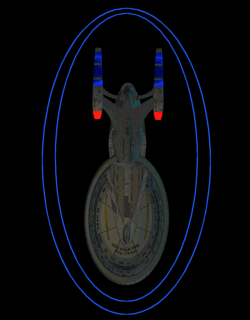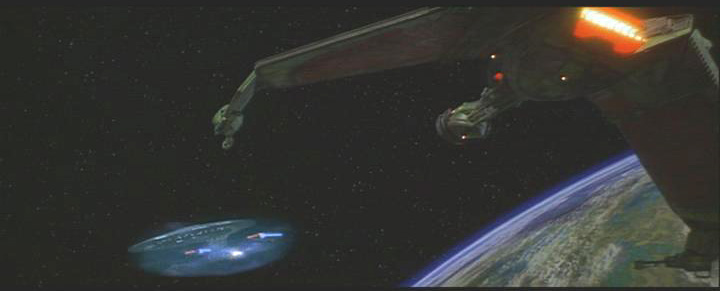Tactical Department
In combat situations the Tactical
department's role is vital because Tactical officers man all offensive and defensive
systems on the base. They must have knowledge about a wide variety of weaponry, and
be able to evaluate possible threats. Tactical officers must gather information from
other departments when necessary, including Science (astrometrics), Medical (xenology),
Diplomatic (cultures) and Intelligence. They must work hand-in-hand with Security
and Marine teams.
When not on alert, no Tactical Officer shall fire on an
unarmed or disabled vessel with the intent to destroy unless good and reasonable cause is
presented, or if a ranking officer orders it. If possible, Tactical Officers must
try to disable the opposing force before destruction unless a ranking Officer orders
otherwise.
Shield Operation
The shield system provides all Starships and Star Fleet facilities
with protection against both violent natural phenomena and enemy weapons fire. Most
shield systems are composed of highly focused spatial distortions which contain an
energetic graviton field. The shield itself is projected by a set of transmission
networks located from emitters located either on the hull of the ship/base or from
protected locations (if on ground based location); when matter or energy strikes the
shield, field energy is concentrated at that point to create an intense localized spatial
distortion.

The shape of the field can be varied at the discretion of the
tactical officer - the most common configuration is a set of curved fields which interlock
to form a large bubble or dome, although some users prefer to make the shields closely
match the ships hull. In the "bubble" case shield burn-throughs are more
likely, as the shield must enclose a greater volume. However, in the
"conform" case any burn-through that does occur is much more damaging as they
are directly adjacent to the hull. Bubble shields are preferred under certain
tactical situations, conformal shields under others.
Shields are carefully tuned to create windows which allow matter
and energy to pass through under certain specific circumstances - for example, visible
light below a certain intensity is allowed to pass through unhindered. This allows
the crew to see out while the shields are up - or more importantly, to use visible light
sensor systems. This window renders the shields invisible to the naked eye under
normal circumstances. Other windows exist to allow sensors and weapons to operate
through the shields.
Impacts on the shield cause Cerenkov radiation to be released,
often perceived as a flash of colour which "lights up" the shield, rendering it
briefly visible. To an observer it appears that the intruding object bounces off the
shields - in fact the spatial distortion becomes so great that the path of the object is
radically altered, and to an zero-dimensional observer on the incoming object it appears
that it is the starship which has suddenly changed location while his/her course is
unchanged.

For over a century after the invention of the shield it was
impossible to use transporters to beam to or from a shielded location, but to an extent
this limitation has now been circumvented. In general, sensor and weapon windows are
insufficient to allow beaming; while technically there is nothing to prevent a ship
opening a window in its own shields of sufficient size to allow transport, in practice
such windows are almost always large enough to be detected and exploited by enemy vessels
and it is far simpler just to drop the shields briefly altogether. The more modern
Starfleet shield designs have now reached a point at which transporters can be operated
via a large wide-frequency window which is briefly opened over the hull emitters.
This gives greater flexibility in using the transporter during high threat situations, but
it remains a somewhat risky proposition - should an enemy score even a near miss on such a
window the effects on the ship would be considerable.
Beaming through an opponents shields is an altogether more
difficult proposition, but this can be accomplished successfully if the transporter
operator has a detailed knowledge of the shield configuration s/he is attempting to beam
through. A notable example of this is the occasion when the USS Enterprise managed
to beam a crew member on board the USS Phoenix whilst that vessel was engaged in unlawful
operations within Cardassian space, or the Defiants' use of the transporter to board the
Constitution class USS Enterprise whilst that ship was modulating its shields for sensor
operation. Such operations remain the exception rather than the rule, however - and
against the unknown shield configuration of an enemy vessel, beam-through remains
impossible.
The most recent advance in shielding systems is the Regenerative
shield. This system is in use with the most modern generation of Starfleet
vessels. The regenerative shield allows a portion of the enemy fire to be diverted
through the shield generator to reinforce the shield layer - the amount of damage that a
weapon impact does is thus greatly reduced. The effectiveness of the reinforcement
depends on the shield generator design, but typically the effectiveness of a shield will
be increased several fold by the addition of regenerative capacity.
Phaser Operations
The Phaser is the standard Federation beam weapon system. This
type of weapon came into common use c.2255, replacing the laser weapons then in
service. Phaser is an acronym for PHASed Energy Rectification, a term which referred
to the original process by which stored or supplied energy was converted to another form
for release toward the target without any need for an intermediate energy
transformation. Although this term is something of a holdover, it remains true in
modern Phaser systems. Phaser energy is released by the rapid nadion effect.
Rapid nadions are short lived subatomic particles which can liberate and transfer strong
nuclear forces within a class of crystals called fushigi-no-umi.
Most smaller Phaser weapons are deployed in single emitters, also
known as a 'Phaser bank'. Larger and more modern weapons group many emitters into
linear arrays. These use force coupling to allow the energy of one emitter to be
transferred almost instantly to another - a process which can be repeated along arrays of
almost limitless size. This confers many major advantages: it allows a large group
of emitters to discharge their combined energy from any single emitter in the array.
This allows longer sustained beams to be fired, and greatly reduces the recharge and
cooling time since the energy is spread over many emitters. In addition, redundant
feeds to small groups of emitters within the array increase the systems resistance to
battle damage since destroying part of the array will not disable the remaining
emitters. A long array can also bring the whole firepower of every emitter to bear
within one single beam - a vessel equipped with many separate Phaser banks must combine
separate beams to accomplish this, something which the firing arcs of the weapons may not
allow.
the Type 12 Phaser has been used in dedicated planetary defense
arrays, and as the main armament of heavy fortified Starbases since 2263. It was
considered that the Type 12 was too unsuitable for use on a starship platform because the
energy requirements of the array where too high and the supporting hardware too
bulky. However, by 2368 the power plant of Starships had grown large enough to
support Type 12 arrays in place of the more common Type 10 models; technical improvements
had also allowed for considerable shrinkage in the size of the equipment. The
Sovereign and Prometheus classes currently utilize Type 12 arrays. These are the
most powerful Phaser weapons currently in use by the Federation.
It has long been recognized that the initial impact of a Phaser
strike on a shield system is the most damaging part of the firing sequence. Many
cultures have sought to increase weapon effectiveness against shields by developing pulse
cannon - that is, weapons which fire large numbers of tightly packaged bursts rather than
a continuous stream. Early Federation vessels such as the Constitution class where
equipped with such pulse cannon, but the weapon is not without its drawbacks; the hardware
involved tends to be very difficult to manage precisely, resulting in much poorer control
over the beam characteristics. The Federations starship design ethic has always
stressed that full control must be maintained over all weapons at all times, in order to
allow non lethal force to be used in starship combat situations; in addition, many
scientific experiments use weapon systems to apply energy in controlled amounts to
external phenomena in order to study reactions. Given this, the Federation gradually
moved away from pulse cannon. The refit given to the Constitution class in the
2270's removed the pulse firing feature from that class, equipping them with a 'rapid
burst mode' which was something of a compromise between pulse and continuous Phaser
beams. Further designs continued to de-emphasize the pulse firing feature, although
all basic Phaser hardware is capable of firing relatively short bursts and this has
remained a feature of Federation combat tactics.
With the development of the Defiant class vessels, the pulse
Phaser cannon was finally reintroduced to Starfleet. The Defiant class is a warship,
pure and simple; her designers had no real interest in conducting experiments, and the
attitude towards the level of lethality of her armament could perhaps best be summed up by
the phrase 'take no prisoners'! Defiant's main armament comprises four heavy pulse
cannon which fire very tightly confined bursts of Phaser energy for maximum impact on
shielding systems. High overall energy delivered over a very short period combines
with a high firing rate to produce a performance against modern shield systems which can
best be described as devastating. Ships which may have successfully withstood
several sustained bursts of fire from a standard array, would have their shields cut
through in moments with a Phaser Cannon. Subsequent combat experience has shown the
value of this weapons system, which is currently being developed for use in other vessels.

